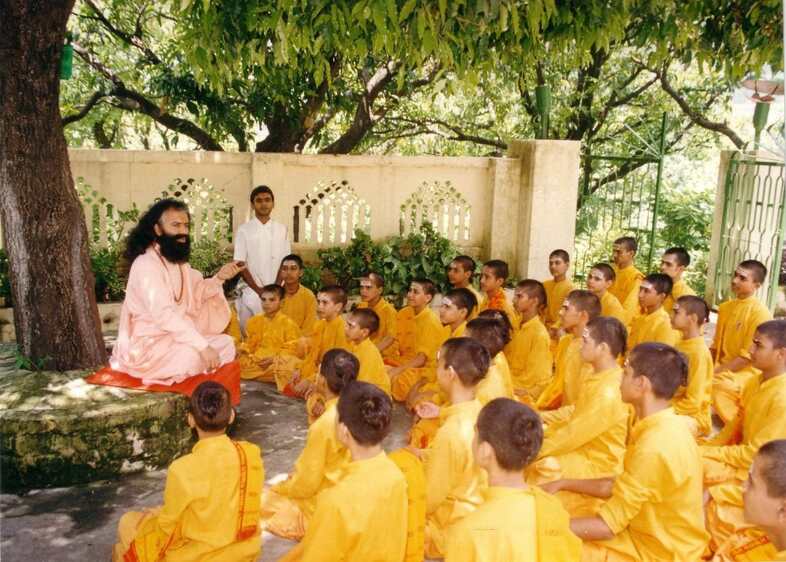Renaissance for reform
Introducing Vedic study methods into modern subjects could enrich students’ learning experience and instil existential confidence within them

There is considerable talk of having an education board blending Vedic studies with modern subjects, leading to innovation in the curriculum and teaching-learning practices. The Ministry of Education has also referred to possible moves in this direction. Given the contemporary environment, simulating the gurukul may not hold popular appeal, but there are numerous lessons that modern education systems can borrow from Vedic teachers.
This rich tradition holds an intellectual charm for academics to blend the ancient and the modern. Indeed, there is talk of a blended curriculum, although this is not new. Present-day gurukuls, while imparting education in Vedic texts, and teaching arts and sciences in Vedic tradition, also tend to bring in courses of study under present school boards. Some notable examples of institutions preserving the Vedic legacy are Dayanand Anglo-Vedic Public Schools and Universities, Aurobindo Institutions, Rishi Valley School in Andhra Pradesh, Swaminarayan Gurukul in Rajkot, Maharshi Sandipani Rashtriya Ved Vidya Pratishthan (MSRVVP) in Ujjain (having 450 organizations affiliated with it), Om Shantidhama's Vedic Gurukul in Kanakapura (Karnataka), Hemachandra Sanskrit Pathshala in Ahmedabad and gurukuls run by religious trusts in Maharashtra's Kaneri district and Rajasthan's Jodhpur.
Education in Vedic times was characterised by the divinity underlying the learning tradition. This divinity was the core of Vedic studies, accentuating the importance of the subject of study, invoked through learning methods and mantra chanting, conveying reverence for the discipline and the teacher. Very often, this less understood concept of divinity in the ancient tradition is mistakenly labelled as religious education. The defining feature of the period was the centrality of learning to life, as the first 25 years of human life were dedicated to learning, leading to an all-round development: He who does not have knowledge, application, is lacking in generosity, wisdom, good behaviour, positive attributes, and is devoid of concept of righteousness, remains a primitive life form.
The Vedic credentials are well known and its contribution to the modern curriculum is well-established. But in practice, there is much value that is yet to be mined. The trinity of science, segueing through various disciplines, understood through applied practice, with the scientific method intrinsic to learning, were part of the ancient tradition. The pedagogy plumbed the interconnectedness between disciplines, was interactive, driven by inquiry, and application-oriented. Shastrarth or intellectual debate involved critical analysis, reflection, interpretation, group discussion, questioning; and those having the most convincing argument prevailed in public debates. Rote learning was given a prominent place in the verbal tradition of Shruti-Smriti, laying emphasis on training in speech and memorisation. All very useful and desirable skills in today's world of work. The six schools of Indian philosophy propounding logic, epistemology, cosmic consciousness, yogic practice, philology, metaphysics and scriptural expositions represented prominent competencies of an intellect refined through education. Ayurveda (straddling both allopathy and homoeopathy) and other ancient treatises on metallurgy, mathematics, architecture, sutras or theorems, astronomy, astrology etc were closely reflected in components of daily life like weather forecasts, nutrition, medicine, agriculture, town planning etc.
Rediscovering the greats through a blended curriculum would help in modern appreciation of our ancient legacy, and not without relevance. The works of Charak and Sushruta —practitioners of medicine and surgery, Patanjali's Yoga, Panani's Ashtadhyayi on Sanskrit grammar, while couched in 'religious language' are not only relevant but also form frame of reference for the modern-day syllabi. The concept of infinity finds eloquent expression in the Upanishads: From wholeness comes wholeness. Aryabhata was the first to give approximate value to Pi which was incommensurable, correct to four decimal places, much before the western world. Another verse from the treatise SulabhSutras translates: praise of Lord Shiva, Lord Indra gives the value of Pi up to 32 places after the decimal, which is the same when digitally calculated. This value was used by Varahamihira, the ancient Indian Astrologer! Even the Srimad Bhagawad Gita is a frequently quoted book on management, by management gurus. And there are interesting conversations around Sanskrit being deemed as a suitable language for computer applications.
While there can be no last word on this ancient tradition, a closing note will not be amiss — a sensibility steeped in Vedic spirituality, fostered over years through intellectual discipline, yoga and meditation holds the promise to not only provide life's most valuable lessons but will help students manage competitive stress and to deal with existential anxieties.
The writer is MD and Co-founder of Primus Partners. Views expressed are personal



